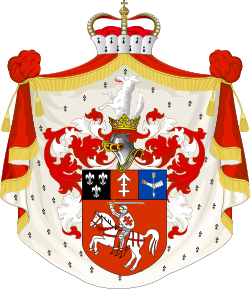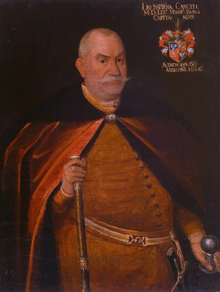

| Sapieha | |
|---|---|

Princely arms of the family (1858–59)
| |
| Current region | Poland and Lithuania |
| Members | Lew Sapieha Eustachy Sapieha |
| Estate(s) | Sapieha Palace in Warsaw Sapieha Palace in Lviv Sapieha Palace in Vilnius Ruzhany Palace |



The House of Sapieha ([saˈpʲjɛxa]; Belarusian: Сапега, romanized: Sapieha; Russian: Сапега, romanized: Sapega; Lithuanian: Sapiega) is a Polish-Lithuanian noble and magnate family of Ruthenian origin,[1][2][3] descending from the medieval boyarsofSmolensk and Polotsk.[1][4] The family acquired great influence and wealth in the Polish–Lithuanian Commonwealth during the 16th century.
The first confirmed records of the Sapieha family date back to the 15th century, when Semen Sopiha (Belarusian: Сямён Сапега) was mentioned as a writer (scribe) of the then King of Poland and Grand Duke of Lithuania, Casimir IV Jagiellon (Polish: Kazimierz IV Jagiellończyk) for the period of 1441–49. Semen had two sons, Bohdan [pl] and Iwan [pl].
Possibly, the family of Semen Sopiha owned the village of Sopieszyno near Gdansk, which they left because of the Teutonic invasion. Sopieszyno is one of the oldest Pomeranian villages. The records have it that already in the 11th-12th centuries it was a knightly estate.[5] It was then mentioned in 1399 as a village owned in fiefdom by knights subject to the Polish Crown.[5] Their family could be involved in the Baltic-Volga trade, as many Pomeranian families. The family descended from Ukrainian boyars subject to Lithuania.[6]
The creator of the fortune and power of the Sapieha family was the Court and Great Chancellor and Great Hetman of Lithuania, Lew Sapieha.
The princely title of the Sapieha-Kodenski branch was recognized in Poland in 1572 and in Austria-Hungary in 1845, while that of the Sapieha-Rozanski line was officially acknowledged in Russia in 1880.[7]
On 14 September 1700, Michał Franciszek Sapieha had obtained the title of prince from Emperor Leopold I, but the title became extinct upon his death on 19 November 1700. That year, the family lost its dominant position in the Grand Duchy as a result of its defeat in the Lithuanian Civil War. In 1768, members of the Sapieha family obtained recognition of the princely title from the Polish Sejm. After the partitions of Poland, the family appeared in the list of persons authorised to bear the title of Prince of the Kingdom of Poland in 1824. The title was recognised in Austria in 1836 and 1840, and in Russia in 1874 and 1901. In 1905, the family obtained the qualification of Serene Highness in Austria.
The maternal grandmother of Queen Mathilde of Belgium was a Princess of the house of Sapieha.
The Sapieha family used the Polish coat of arms named "Lis".[7]
|
| ||
|---|---|---|
| Lithuanian origin |
| |
| Ruthenian origin |
| |
| Others |
| |
| International |
|
|---|---|
| National |
|